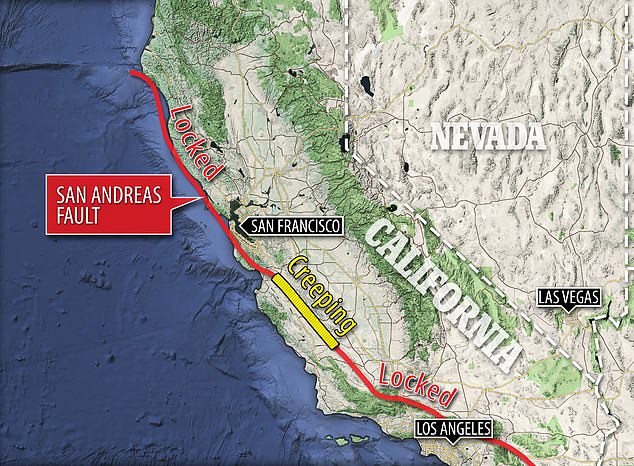California breaks record for most 4.0 magnitude earthquakes in one year, fueling fears of ‘the big one’
Southern California broke the record for most earthquakes of magnitude 4 and above in one yearafter a magnitude 4.7 earthquake and on Thursday, Malibu was hit by five aftershocks.
Seismologist Lucy Jones of the US Geological Survey (USGS) said in a televised interview after the quake that the average number of magnitude 4 and higher earthquakes in this region is about eight per year.
“So far we’ve had 14 in Southern California. The highest number of cases was last year, 13.”
The unusually high number of earthquakes in recent weeks has raised fears that the increase in seismic activity in the region could be the much-anticipated ‘big confirmation’.
Three earthquakes with a magnitude of 4 or greater have struck Southern California in the past month. The record-breaking seismic activity has locals worried about ‘the big one’
“The big one” refers to a hypothetical high-magnitude earthquake that could one day occur along California’s San Andreas Fault, which stretches 800 miles (1,300 kilometers) along the state’s coastline.
Researchers estimate that such an earthquake would cause about 1,800 deaths, 50,000 injuries and $200 billion in damage.
Scientists can’t predict earthquakes, but they have long warned of the inevitability of “the big earthquake.”
In fact, California is already overdue for this. Major earthquakes typically occur every 150 to 200 years, but the San Andreas Fault has not had one in more than three centuries.
The recent surge in seismic activity in Southern California has locals wondering if “the big one” is coming. Many took to X, formerly Twitter, to share their concerns.
“The big one is coming (really)… this is the third earthquake in how many weeks???” wrote one X user after the 4.7 magnitude quake that struck Thursday morning.
If the Big One were to actually hit, “it would be a matter of tens of seconds before the shocks from a San Andreas event affecting the areas closest to Los Angeles would reach our urban areas,” Jonathan Stewart of the University of California, Los Angeles previously told DailyMail.com.
In recent weeks, record numbers of earthquakes have occurred in this region.
On August 6, Bakersfield was hit by a 5.3 magnitude earthquake that was felt over a hundred miles away at Dodgers Stadium, where nearly 50,000 people were attending a game. Fortunately, no one was injured.

The monstrous San Andreas Fault splits California from south to north, caused by two tectonic plates slowly grinding against each other – always on the edge of ‘the big one’

Seismologist Lucy Jones said the recent increase in seismic activity in Southern California is not a sign that the San Andreas Fault is about to rupture
A few days later, on August 12, Pasadena was hit by a 4.4 magnitude earthquake, in “essentially the same location” as the 3.5 quake that struck in June, Jones wrote on X after the event.
Thursday’s quake was initially reported as a magnitude 5.1 but was later downgraded to a magnitude 4.7. The epicenter was five miles (8 kilometers) north of Malibu and the quake was seven miles (11 kilometers) deep, the USGS said.
A few minutes later, a magnitude 2.8 aftershock struck, followed by four more, magnitudes 2.7 to 3.5, over the course of about an hour. There have been no reports of significant damage or injuries.
This latest event marks the 14th magnitude 4 or greater earthquake to hit Southern California this year.
But Jones answered “no” when asked whether this increased activity means “the big one” is coming, the New York TimesAccording to her, frequent, smaller tremors do not mean there is a greater chance of a major earthquake.
In fact, despite the recent increase in earthquakes, overall seismic activity in Southern California has been relatively quiet since 1993, she said.
This year, however, the region has seen a marked increase in the number of earthquakes with at least one quake measuring magnitude 4 or greater, Jones said.
By mid-August, there were more than a dozen such series. This is a significant increase compared to previous years – there were only six in 2023, two in 2022 and four in 2021.
But Jones said those numbers are “not yet statistically significant,” meaning experts can’t be sure whether the increase is part of a larger trend or just an isolated incident.
So scientists can’t infer any information about “the big one” from these latest quakes. But advances in earthquake forecasting could eventually help us put a timeline on when it might happen.
For example, a new study has discovered a correlation between fault line strength and earthquake size. This could be a way to determine how close an area is to a major earthquake.
The researchers emphasize that this does not mean we can predict the exact timing of a future earthquake.
But the findings could help scientists estimate when a fault has reached a critical point “where only a small extra push is needed to start the fault slipping,” said lead researcher Satoshi Matsumoto, director of Kyushu University’s Institute of Seismology and Volcanology.
“This information is critical to being prepared for major earthquakes,” he added.
